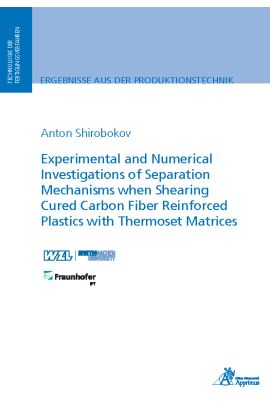In order to curb climate change, CO2 emissions from road vehicles are limited by law. One possible way of reducing these emissions is to increase fuel economy by reducing vehicle weight. Due to their superior specific material properties, carbon fiber reinforced plastics (CFRP) have a high lightweighting potential. However, the high cost of CFRP components restricts their usage in high-volume applications. To enable such applications, the manufacturing costs of CFRP components have to be reduced.
CFRP components are manufactured to near-net shape and often have to be pierced or trimmed in a finishing operation. Shearing is a manufacturing technology that is suitable for trimming and piercing of CFRP components. Furthermore, shearing is potentially more cost efficient in mass production than the finishing technologies currently used. However, due to the novelty of this approach, the cause-and-effect relationships between the shearing process and the material parameters and the resulting process and workpiece related characteristics are not known. Therefore, in order to support the industrial adaptation of this technology, a knowledge-based design of cost efficient CFRP shearing processes has to be enabled.
In this thesis, the separation mechanisms and the economic efficiency of shearing CFRPs are systematically analyzed and explained. Specifically, the dependence of CFRP separation in shearing on fiber orientation in relation to the cutting line was experimentally studied using unidirectional laminates. An integral characterization system has been developed to quantitatively and unambiguously assess the sheared edge quality of multidirectional CFRP laminates. The cause-and-effect relationships between the material and process parameters and the resulting cutting force, sheared edge quality, geometrical and form accuracy as well as delaminations were established using the developed characterization system, and explanations for the observed phenomena were formulated. Furthermore, a finite element process model of CFRP shearing was developed to further the understanding of separation mechanisms. Finally, cost modeling was used to determine production-related boundary conditions for the cost efficient deployment of CFRP shearing. The findings contribute to a deeper understanding of the technological, physical, and economic aspects of CFRP shearing and, thus, enable the knowledge-based design of this process.
| Autor | Shirobokov, Anton |
|---|---|
| Lieferzeit | 3-4 Tage |
| Gewicht | 0.316 kg |
| Erscheinungsdatum | 16.11.2018 |
Technologie der Fertigungsverfahren
Experimental and Numerical Investigations of Separation Mechanisms when Shearing Cured Carbon Fiber Reinforced Plastics with Thermoset Matrices
Kurzbeschreibung
Shearing is a cost efficient technology suitable for piercing and trimming of components made of carbon plastic reinforced plastic (CFRP) in high-volume automotive applications. In order to support an industrialization of this process, the material separation mechanisms when shearing CFRP were studied and explained using experimental and numerical approaches. The findings of this thesis provide a foundation for a knowledge based design of economically efficient CFRP shearing processes.

